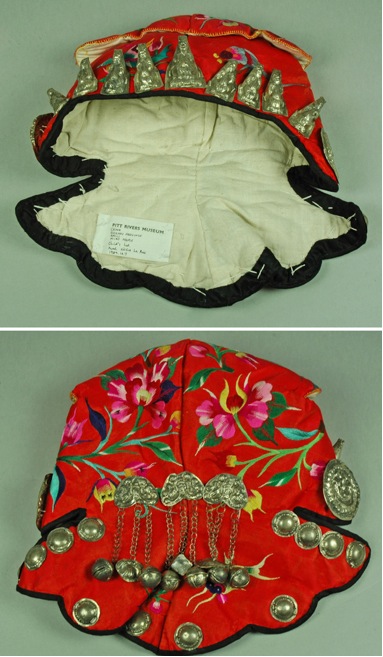Tiger hat
Hmong (Miao) people, Guizhou Province, China, 1980s
 Collected by Hélène La Rue and purchased from her in 1989; 1989.16.7This is a hand-made child's embroidered and decorated silk hat. It is lined with cotton. Although they are lying flat in these images, there are two small ears protruding from the top of the hat, representing a tiger. During the Qing dynasty and early 20th century, children's (especially boys') clothing was often decorated in auspicious creatures to protect against evil spirits that might whisk the child away. Whilst this custom has declined in urban areas, it can still found in more rural areas of central China.
Collected by Hélène La Rue and purchased from her in 1989; 1989.16.7This is a hand-made child's embroidered and decorated silk hat. It is lined with cotton. Although they are lying flat in these images, there are two small ears protruding from the top of the hat, representing a tiger. During the Qing dynasty and early 20th century, children's (especially boys') clothing was often decorated in auspicious creatures to protect against evil spirits that might whisk the child away. Whilst this custom has declined in urban areas, it can still found in more rural areas of central China.
The tiger is a popular choice because it is a divine creature in Chinese folklore. A tiger hat scares away evil spirits or fools them into thinking that the child is a fearsome animal. If the tiger hat is worn on birthdays or special occasions, it is supposed to bring luck and peace. Yet the hat does not rely on the tiger alone and employs other charms too; at the front edge are auspicious silver ornaments including figures of the 88 Buddhas, whilst the back is decorated with silver butterfly badges with bells and other lucky objects suspended in sets of threes. The colour red, the flowers on the fabric and the creatures and charms are all symbolic of good fortune and a long life.
Sometimes a child will not just have a tiger hat but also tiger shoes, tiger toys and even tiger pillows; the ancient medical sage Koh Hung advised in his writings that a child's' nightmares were best prevented by using a pillow made of a tiger's head or at least, resembling it. Images of the tiger carved in metal or wood are still worn or hung on doors as charms against demons or disease. Many other animals found in the Chinese calendar are incorporated into children's shoes or bootees, rendered in bright red, purple or orange silk or satin. An animal design is usually chosen for specific quality that might help protect the child: the alert phoenix (rooster), the loyal and fearsome dragon, the intelligent pig, or the astute and lucky rabbit.
The Chinese rites of passage associated with the life-cycle rituals of birth, marriage and death have been subjected to a great deal of standardization over the centuries. However China, unlike Europe that had a central, unified religion (Christianity) to ordain on such matters, had rulers who were more content to practice orthopraxy rather than orthodoxy; controlling practice and moral conduct in a way that was not deviant but allowed for local interpretation and custom. For example, in rural Zhejiang Province in eastern China, life-cycle rituals remain important. When a woman gives birth, the father relays the news to the maternal grandmother. She learns about the sex of the baby by a red string her son-in-law has tied around either the spout (a boy) or the handle (a girl) of a pewter teapot he has brought for her to fill with wine. Sequential rituals are held to celebrate the child's third full day, first full month and first full year of life through the exchange of gifts, cakes and zongzi (rice-stuffed leaves) among relatives, and the presentation of clothing to the infant. Some articles of clothing might be stitched with lucky symbols or animals. At each birthday thereafter the child eats 'longevity noodles', noodles fortified with extra eggs to ensure growth and a long future.
